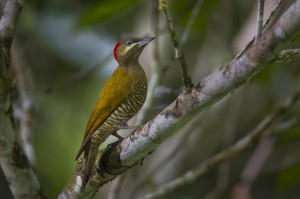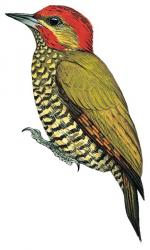Week 24 – 25 December 2016:
Things We Know and Things We Don’t
Birds are, without a doubt, the best known creatures in the world. Most are brightly-coloured, reasonably large and abundant, display interesting behaviours, and are particularly active during the day. Consequently birdwatching is a hobby; wormwatching isn’t. Birds have been under scientific scrutiny for centuries, and much of what we know about the natural history of animals in general is based on what we first learned about birds.
Some bird species are much better studied than others of course. Thousands of scholarly publications have considered the lives of Mallards and Barn Swallows, partly because they are both common species found in places with lots of people to watch them. At the other end are Black-browed Babblers and Cayenne Nightjars about which we know almost nothing, particularly because they are extraordinarily rare. They reside in countries with very few bird biologists, and may have already fallen to extinction.
In terms of our knowledge of natural history, most species of birds fall somewhere in the middle. They are reasonably common and we know quite a bit about them. There are, however, exceptions.
The International Union for the Conservation of Nature considers the Stripe-cheeked Woodpecker, Piculus callopterus, to be of least conservation concern. A species endemic to Panama, they are not wildly common and have a patchy distribution, but at least their numbers seem stable. So why is it that we know so little about them? In part the answer is that the forests of the foothills of eastern Panama are very difficult to access.
Until recently no one had ever reported seeing the nest of one of these Panamanian woodpeckers. A 2015 publication by William Adsett and Leslie Lieurance changed all of that. In April and May of 2013, Adsett and Lieurance had the great fortune to observe the comings and goings of a pair of Stripe-cheeked Woodpeckers attempting to raise chicks in forest in Chagres National Park in the foothills of eastern Panama.
By great fortune, the pair of birds choose to excavate a nesting cavity in a Cecropia tree very close to Adsett’s home. When I contacted him, Adsett explained that he and his wife own a property within the Altos de Cerro Azul, a residential development of 2000 lots within Chagres National Park. This region represents one of the highest and wettest parts of the entire watershed of the Panama Canal. “We are fortunate in having the Stripe-cheeked Woodpecker frequently in our bit of the forest,” Adsett explained, “but it was sheer luck that the pair nested in sight of our house.”
A combination of direct observation and time-lapse video footage provided Adsett and Lieurance with our first insights into the private lives of breeding Stripe-cheeked Woodpeckers. For instance, the opening to the nesting cavity was 3.4 metres (11 feet) from the ground where the tree was 20 centimeters (8 inches) in diameter. It took nine or ten days from the start of excavation until the first egg was laid, and incubation lasted 12 or 13 days. Both parents incubated the eggs and fed the young, but it was the male that made the greatest number of feeding trips and spent each night in the nesting cavity.
I wish that I could report a happy ending, but I can’t. The young woodpeckers died 17 or 18 days after hatching, which was about a week before they might have been expected to leave the nest. Although they could not be certain, Adsett and Lieurance felt that failure was likely attributable to predation. A large column of army ants was observed to enter the nest, but whether they were responsible for the death of the chicks is unknown. It is possible that a nocturnal predator took the nestling, either dead or alive, after the ant attack.
“It is our guess that this species do not generally return to the same nest hole for a second or third attempt – the trunks just deteriorate too fast.” Adsett explained that cavity-nesting in the tropics can be a precarious business. The excavation of a different nest in a dead tree by the same species caused the trunk to snap off just days after completing the hole.
Adsett, W. J. and L. Lieurance. 2015. First breeding record, vocalisations and morphology of Stripe-backed Woodpecker Piculus callopterus, a Panamanian endemic. Cotinga 37:79-86.
Photo credits: Stripe-cheeked Woodpecker, © Paul Jones – www.flickr.com/photos/paulbjones/24765456272; drawing of a Stripe-cheeked Woodpecker - www.hbw.com/species/stripe-cheeked-woodpecker-piculus-callopterus



